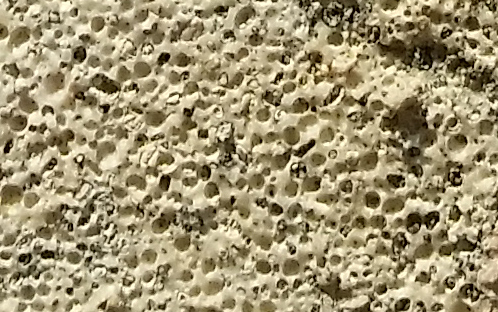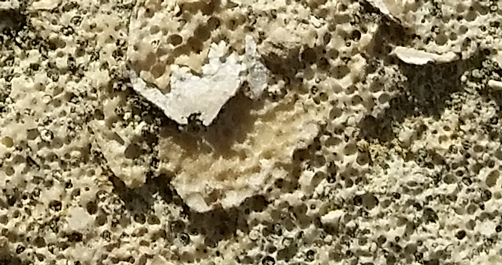Oolite (Egg Stone) Get up Close to Limestone
One of the joys of having Smartphones around the office is that these can be borrowed and taken out on fossil hunting expeditions. Yes, they have all sorts of features, most of which we don’t use, but the camera has proved a boon. With twenty megapixels to play with team members have been able to take some lovely photographs of fossil discoveries and geological landscapes. With this sort of imaging technology widely available there are more pictures of fossils being taken than ever before, but sometimes the rocks that contain the fossils can prove to be just as interesting, take oolitic limestone for example.
Oolitic Limestone
A Photograph of Oolitic Limestone (Building Stone)
Picture credit: Everything Dinosaur
Cotswold Building Stone
The picture above shows Cotswold building stone (Middle Jurassic), limestone that was laid down in a marine environment and a number of small shelly fossils have been preserved along with natural casts of shells. If you were to run your hand over this finely chiselled piece of building stone it would still feel quite rough, having the texture of coarse sand paper. It is oolitic limestone, otherwise known as “egg stone” and close up the surface of the stone has a remarkable appearance.
A Close Up of the Limestone Material
Picture credit: Everything Dinosaur
The powerful digital camera on the Smartphone can pick up fine details such as the small, bubble-like appearance of the surface of the limestone. These are the remnants of the ooliths (sometimes also called ooids) that make up the rock. Grains of sand or fragments of seashell are rolled around the sea floor and as they do, they collect calcium carbonate (CaCO3). Concentric layers are formed and these give the rock its characteristic “egg stone” appearance, as the surface of the rock looks like fish roe (fish eggs). Hence the term oolitic limestone.
Limestone Oolite (Egg Stone)
Oolite (egg stone) is sedimentary rock and although most ooids are formed from the collection of calcium carbonate, this is not always the case as these structures can be composed of phosphate, dolomite or even chert. The ancient Greek word for egg is òoion and this might be the source of the derivations associated with this geologic structure.
In geology, sedimentary rock can be classified according to the composition of the rock as well as the diameter of the “egg stone” structures that are observed within it. For example, oolites are technically defined as being composed of ooids that range in diameter between 0.25 mm to 2 mm.
Classifying the Rock Types
Rocks composed of ooids of a larger than 2 mm diameter are called pisolites (made up of spherical shapes called pisoids). The terms pisolite and pisoids come from the ancient Greek word for pea, so think of the size of the spherical shapes observed in the stone like a group of small peas.
Oolitic Limestone can be Full of Fossils
Picture credit: Everything Dinosaur
Ooids are normally formed in warm, shallow seas that contain a lot of calcium and other minerals dissolved within the seawater. Intertidal movements or currents aid in the transport of the material which helps in the formation of the ooid structures, but oolitic material can also form in freshwater. Fragments of shell or a sand grain can act as a “seed” giving the calcium carbonate a medium which it can form around.
As these tiny “seeds” tumble around the sea bed they accumulate layers of precipitated calcite (another term for calcium carbonate), the size of the ooid (or pisoid) formed indicates the length of time the object has been exposed to the sea water before being buried by further sediment deposition.
Size Indicates Time on the Seafloor
Therefore, pisoids, being larger than ooids have been present on the seafloor longer than ooids. Oolites with their “egg stone” grains superficially resemble sandstone and they can be white, grey or even yellow in colour (such as Portland limestone). Under a high powered magnifying glass (or within a 20 megapixel image), the concentric rings which form the ooids can be easily made out.
Oolitic limestones are popular building materials, for example Cotswold limestone (oolitic limestone), as they are hard, resist erosion and come in a variety of hues and colours. As they have an even structure they can be cut or sculpted in any direction. Take a look at some of the older, stone buildings in your town. If you live in the UK, chances are that some of these building stones are oolitic limestone and if you have a powerful camera you can record surface details yourself and record the ooids.
For models and replica of Jurassic dinosaurs and other prehistoric creatures: Nanmu Studio Jurassic Series Dinosaur and Prehistoric Animal Models.









Leave A Comment